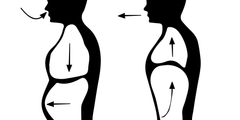
Forget emergency situations - stress has become an inevitable part of modern daily life. And that’s not good. Stress can have detrimental effects on mental, emotional, and physical well-being. The good news is there’s several techniques that are not only effective, but simple, cheap and require nothing but a few moments. Deep breathing exercises can help calm the mind and reduce anxiety.
In this blog post, we will discuss five breathing techniques that can alleviate stress. We recommend you test out each exercise and select one or two that are most comfortable for you.
1. Diaphragmatic Breathing:
Also known as belly breathing or abdominal breathing is a technique that involves breathing from the diaphragm, where the belly expands and contracts with each breath. This type of breathing stimulates the relaxation response and reduces stress. To practice diaphragmatic breathing, lie down on your back or sit up straight, place one hand on your chest and another on your stomach. Take a deep breath in through the nose, and feel your stomach expand. Hold the breath for a few seconds and breathe out slowly through the mouth, feeling the stomach move back in.
2. Alternate Nostril Breathing:
This breathing technique, also known as Nadi Shodhana, helps to balance the right and left hemispheres of the brain, which calms the mind. To practice alternate nostril breathing, sit comfortably with a straight spine. Using your right hand, place your thumb on your right nostril and inhale deeply through the left nostril. Use your ring finger to close the left nostril and exhale through the right nostril. Inhale through the right nostril, close it with your thumb and exhale through the left nostril. Repeat this for a few minutes.
3. Box Breathing:
Box breathing is a technique that helps to control and regulate breathing, which calms the mind and reduces stress. It involves inhaling for four counts, holding for four counts, exhaling for four counts, and holding for four counts. To practice box breathing, sit comfortably with a straight spine. Inhale through the nose for four counts, hold for four counts, exhale through the mouth for four counts, and hold for four counts. Repeat for a few minutes.
4. 4-7-8 Breathing:
The 4-7-8 breathing technique is a simple yet powerful method that involves inhaling for four counts, holding the breath for seven counts, and exhaling for eight counts. This breathing exercise helps reduce anxiety and promote relaxation. To practice 4-7-8 breathing, sit comfortably with a straight spine. Inhale through the nose for four counts, hold the breath for seven counts, exhale through the mouth for eight counts. Repeat for a few minutes.
5. Breath Counting:
Breath counting is a mindfulness technique that involves focusing on the breath and counting each inhalation and exhalation. This technique helps to calm the mind and reduce stress. To practice breath counting, sit comfortably with a straight spine. Close your eyes and focus on your breath. Count each inhalation and exhalation until you reach ten. Start again at one and continue for a few minutes.
Conclusion:
Next time you find your stress escalating, remember these techniques, which you can use anywhere and anytime. Over time, you will find that these breathing techniques become a natural part of your daily routine to help you manage stress effectively, and can help you remain level-headed during an emergency situation.